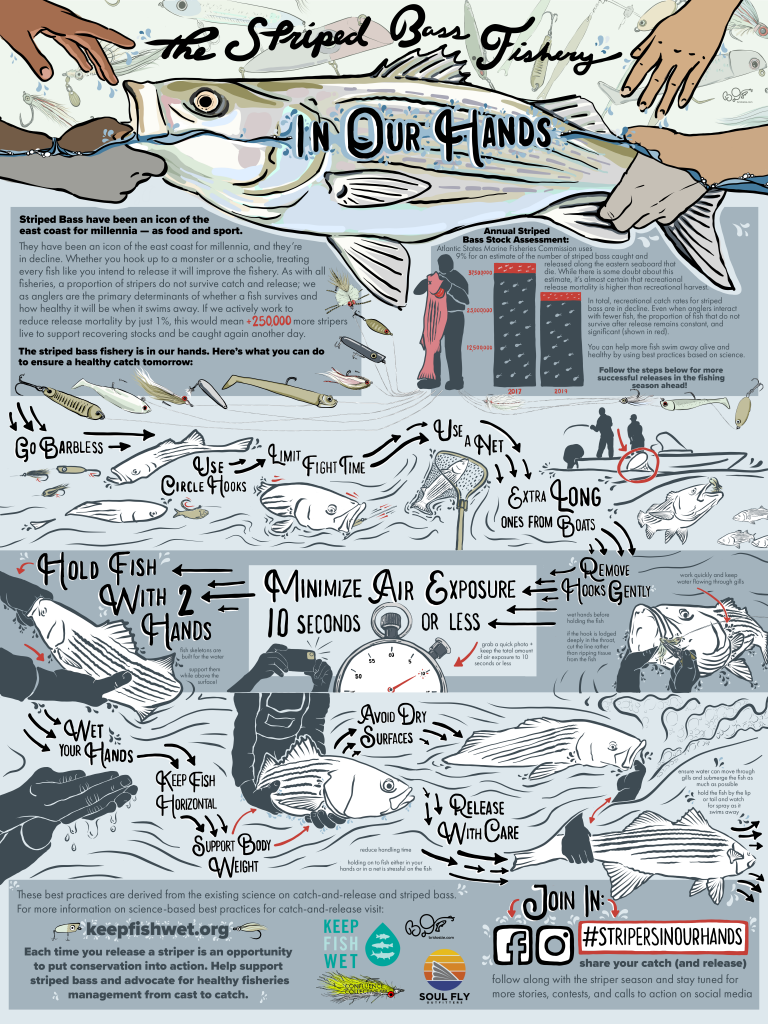The Striped Bass Fishery In Our Hands

Our friends and conservation partner Keep Fish Wet have teamed up with Confluence Collective, Soul Fly Outfitters and Maine based artist and angler Bri Dostie to develop a grassroots campaign to help address recreational catch and release mortality.
The Striped Bass fishery is one of the most popular recreational fisheries in the United States. The most recent ASMFC stock assessment released in 2019 showed that over 41 million fish were caught in the recreational fishery. And as striped bass anglers travel, fish, and shop along the east coast, they inject millions of dollars into local economies.
Currently, Striped Bass populations are at a 25 year low according to the Atlantic States Marine Fisheries Commission. While commercial harvest has decreased somewhat and the recreational harvest has been declining steadily since 2015, it’s estimated that the largest portion of mortality in the fishery comes from fish that are caught and released but do not survive. This is where recreational anglers have the ability to play a significant role and create positive change.
Scientist quote: “Just saying practice catch-and-release isn’t good enough, since not all fish that are released survive,” said Dr. Andy Danylchuk, Professor of Fish Conservation at UMass Amherst, and Science Advisor for Keep Fish Wet. “Fortunately, there is a growing body of science showing anglers can making subtle changes in their behavior and how they catch and handle fish that can reduce release mortality and make a meaningful impact of the fishery we all care about”
“If you choose to release a fish and you would like that fish to live and remain healthy, there are some simple science-based steps you can take,” says Sascha Clark Danylchuk, the Executive Director of Keep Fish Wet. The three most important things you can do are to:
- Minimize air exposure
- Avoid dry surfaces
- Release with care
“Scientists know a lot about how human interactions affect the fish we catch, but that information doesn’t help anyone if it stays in a journal article behind a paywall,” said Dostie. “We wanted to make sure every angler is empowered with the information they need to protect the fish they care about — and art is one way to share that information more broadly.”
The Striped Bass fishery is in our hands. We as anglers have the opportunity to improve survival rates by taking care of every fish we encounter. Take these science-informed best practices for handling fish into consideration next time your on the water:
- Consider going barbless for smooth hook-ups and clean hook removals. If you’re using live bait, use circle hooks.
- Limit fight time: every second on our line adds stress and takes energy from the fish, leaving them with less for recovery.
- Use a net: this can bring fish in fast and is especially helpful when fishing from a boat. Rubberized nets are best, as they do less damage to fins and slime. By using a net we can also keep the fish submerged while removing the hook safely.
- Remove hooks gently: if needed use a tool and cut the line if deeply hooked.
- Minimize air exposure and Avoid Dry Surfaces: 10 seconds out of the water in total, just enough time to remove that hook, snap a quick photo, and prepare for release.
- Hold fish with 2 wet hands to support their weight out of the water, keeping the fish secure while not removing too much protective slime.
- Holding fish horizontally helps avoid damage to the skeletal and organ systems.
- Release with care! Holding a fish by their lip or tail is best, making gripping tools irrelevant. Only revive fish that cannot swim on their own.
The state of the fishery is truly in our hands, even a small improvement in catch and release mortality would have a huge impact in the overall health of the stock. For more information please check out the Stripers In Our Hands page on the Keep Fish Wet website.







